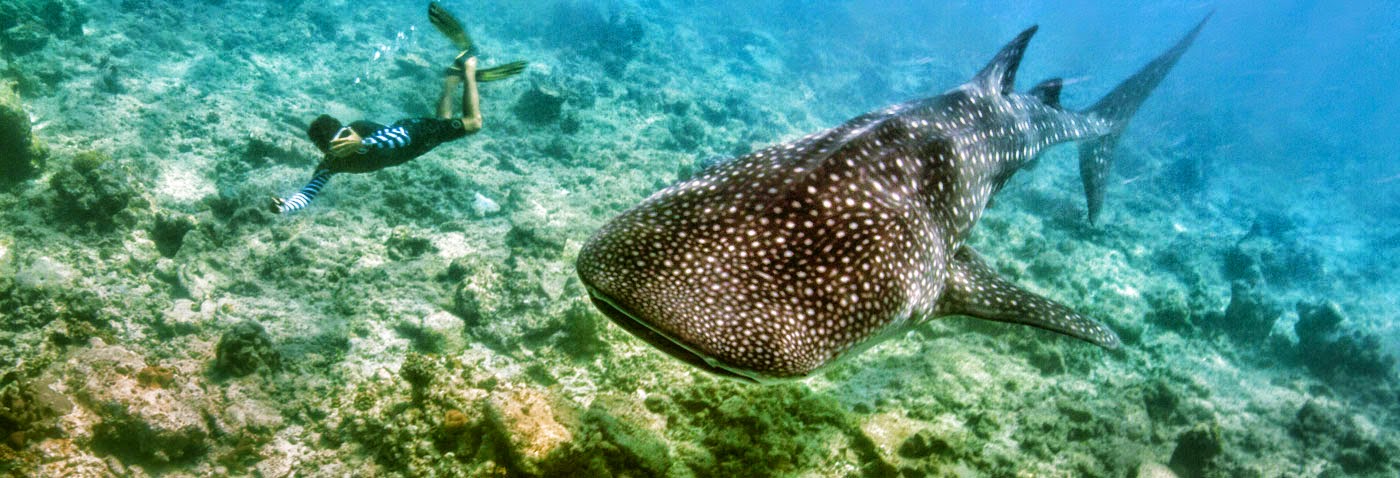It is believed that 3% of global shark wildlife tourism money is spent viewing whale sharks in the Maldives
 Whale Sharks are the largest fish in the world but the impact of this great and fascinating creature on the economy of the island nation of the Maldives is largely unknown.
Whale Sharks are the largest fish in the world but the impact of this great and fascinating creature on the economy of the island nation of the Maldives is largely unknown.
A recent study by the scientists of the Maldives Whale Shark Research Programme (MWSRP) discloses that a small group of whale sharks in a separate Maldivian Atoll take for nearly three percent of the global shark ecotourism and nearly half that of the Maldives.
Inspite of the South Ari Atoll Marine Protected Area (SAMPA) being the most popular whale shark viewing region in the Maldives, this area is as yet uncommitted. The study, published few days back in the journal PeerJ, emphasize how the implementation of a management plan which protects this aggregation site would reduce the possible economic effect that would result from the sharks leaving the area due to stresses from the attention they receive.
The SAMPA was first designated in 2009 and at 42 square kilometers it is the largest protected area in the Maldives. Whilst, an accepted management plan was not reached at the original time of designation. On that account, this study has proven fitting, as dialogue with local communities and tourism industry representatives have again started, with a more purposeful effort with the intention to create a world class whale shark tourism destination.
Researchers from the MWSRP feels that is likely that the whale sharks visit the shallow waters of SAMPA to warm up after diving deep for food.
The South Ari Marine Protected area is known to be the largest MPA in the Maldives and hosts a year-round collection of whale sharks.
Co-author and a director of MWSRP James Hancock said “The Republic of Maldives hosts one of few known year round aggregation sites for whale sharks.”
“We have seen that they have become a major tourism draw to South Ari atoll, but we didn’t expect these big numbers,” he further added.
Figures states the South Ari Atoll Marine Protected Area (SAMPA) alone attracted 77,000 tourists in 2013. This equals to USD9.4mn of direct income to operators who offer the chance to catch sight of this popular must-see creature.
This is the first value that has been contributed to what is a rapidly growing industry in the Paradise.
It is also said to be the first time that an assessment for a wildlife viewing experience has been purposive just from observational studies.
A joint researcher from IUCN and MWSRP and one of the authors of the study Neal Collins said “Instead of surveying tourists and extrapolating results we actually went out and counted how many boats and people were in the water looking for sharks.”
Co-author Fernando Cagua stated “By doing so we were able to estimate not only how many people were interacting with the sharks, but also where and how they do it.”
Fernando added “When we include the whale sharks from South Ari Atoll, we were able to adjust previous estimates of annual ‘shark related’ tourism expenditure in the Maldives from $12 million USD to nearly $20 million.” He also said “There are still many mysteries about these whale sharks – we don’t know why they come here or for how long they stay – but bringing the money issue to the table is an important step towards ensuring their conservation.”
The director of MWSRP said “In a sense the whale sharks here are perfect for wildlife tourism. They are the largest shark in the world and the slow moving, shallow swimming behaviour they exhibit in S.A.MPA waters makes them accessible not just to scuba divers but also to snorkel excursions. This opens up a wonderful wildlife experience to just about everyone, which of course brings with it a degree of risk in terms of the welfare of both the sharks and the tourists.”
He also added “The encouraging thing is that everyone in the industry we talk to agrees these risks need to be managed and the local communities are receptive to participating in the management of the area.”
‘Whale shark economics: a valuation of wildlife tourism in South Ari Atoll, Maldives’ was written by researchers from the Maldives Whale Shark Research Programme and Red Sea Research Center, King Abdullah University of Science and Technology with the support of technical partner IUCN Maldives Program, with funding from Global Blue and USAID. Researchers from the Maldives Marine Research Center and Hubbs Sea-World Research Institute also supplied to the study as consulting body.
The Maldives Whale Shark Research Programme is a registered charity that exists to carry out whale shark research and facilitate community towards conservation strategies in the Maldives and the throughout the South Asian region.





